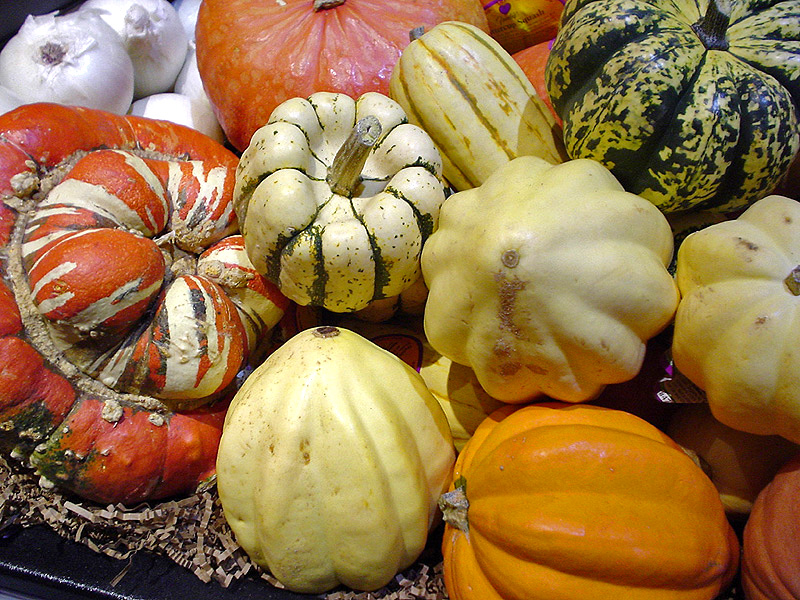
Winter squash is a summer-growing annual vegetable,[1] representing several species within the genus Cucurbita. It differs from summer squash in that it is harvested and eaten in the mature fruit stage, when the seeds within have matured fully and the skin has hardened into a tough rind. At this stage, most varieties of this fruit can be stored for use during the winter. It is generally cooked before eating.
Winter squash, with its mild sweet flavor and grainy texture, is at its peak in November. A member of the Cucurbitaceae family, and relative of the melon and the cucumber, winter squash comes in many different shapes, colors, flavors, and sizes. Varieties include Butternut squash, Acorn squash, Hubbard squash, Turban squash, and pumpkins. Consumed for over 10,000 years, winter squash originated in a region between Guatemala and Mexico. It was initially cultivated for its seeds because earlier versions contained only a meager amount of flesh, which was bitter and palatable. Over the years, squash cultivation spread throughout the Americas and sweeter varieties were developed. Europeans first experienced squash when introduced by Christopher Columbus on his return from the New World. Today, the largest commercial producers of squash include China, Japan, Romania, Turkey, Italy, Egypt, and Argentina.
Winter squash, rich in vitamins and nutrients, fights cancer, supports men’s health, protects the cardiovascular system, and prevents birth defects. It is an excellent source of beta-carotene, as well as a great source of Vitamin C, potassium, manganese, fiber and folate. Together, these health-promoting nutrients may help regulate blood sugar, lower blood pressure and cholesterol, and reduce the risk of heart attack and stroke. Due to its powerful antioxidant properties, found in beta-carotene and Vitamin C, squash may also help alleviate asthma and arthritis by reducing inflammation, a major cause of these conditions. Additionally, diets rich in orange-red carotenoids, found in squash – and vegetables like pumpkin, papaya, peaches, and peppers – have been associated with a reduced risk of lung cancer in smokers.
When shopping for winter squash choose ones that are heavy for their size with no soft spots. Winter squash, unlike summer squash, cannot be eaten in its entirety. To prepare, wash, cut in half, and remove seeds and fibrous material from the cavity. Due to their hard protective skins, winter squash, unlike their summer relative, retains a storage life of up to 6 months. Winter squash can be enjoyed as a main meal or as a healthy sweet treat. For a fresh twist on a classic Italian pasta dish, try "spaghetti" squash tossed with your favorite sauce. It’s also delicious steamed with olive oil and seasonings. Puree cooked winter squash and drizzle with maple syrup, cinnamon, and nutmeg for a sinless way to satisfy your sweet tooth!
Warming Winter Squash Soup
1 medium butternut squash
2 tablespoons extra virgin olive oil
1 large onion, sliced
Low-sodium vegetable stock
sea salt
freshly grounded pepper
cinnamon
curry (optional)
Cut, peel, and remove seeds and fibrous material from squash. Cut squash into cubes. Heat olive oil in a large, deep saucepan. Add onion and sauté. Add cubed squash and enough vegetable stock to cover. Bring to a boil. Lower heat and simmer until squash becomes soft, about 30-40 minutes. Beat with whisk or in blender until smooth. Season with salt and pepper to taste. Sprinkle with cinnamon, and curry (if desired). Enjoy!
No comments:
Post a Comment